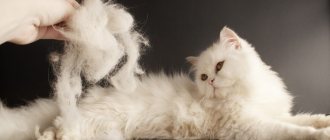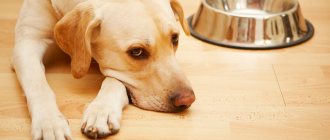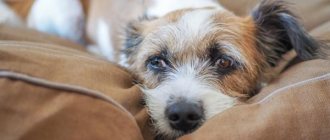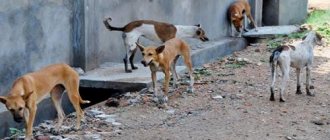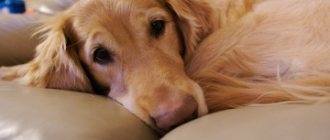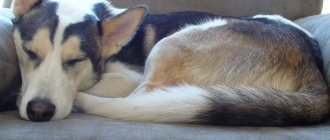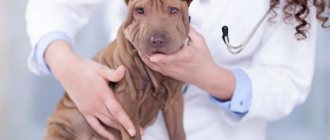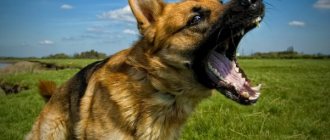One of the indicators of a dog's health is its coat. Smooth, shiny or thick, silky hair often tells the dog owner that everything is in order with the dog’s health. Almost every dog owner knows that 2 times a year dogs experience active hair loss, the so-called seasonal shedding, during which the dog feels normal, and therefore does not worry about its health.
Wool structure. In dogs, hair follicles are combined into groups (bundles) consisting of one, longest, primary (central) hair, surrounded by thinner and shorter secondary (additional) hairs (in puppies there are no secondary hairs). The density of the coat depends on the age and breed of the dog. The softer the wool, the thicker it is. For example, a German Shepherd has 1 sq. There are 100-300 groups of follicles per cm of skin, and 400-600 in dogs with soft hair. The number of groups of hair follicles is determined at birth, but young puppies only have downy hairs that are very soft to the touch. With age, the angle of inclination of the hair to the surface of the skin decreases to approximately 45 degrees until an adult dog.
The dog's owner begins to show his concern when he notices that his friend's once shiny coat is becoming dull and starting to fall out.
Dogs shedding is an absolutely normal phenomenon, but this fact does not in any way save owners from worrying about the pet’s health; in addition, no one is likely to like fur all over the house.
Dog hair and its purpose
Wool is of great importance for a pet because it provides protection from environmental factors. It protects the dog from parasites, infectious diseases and bad weather. It is worth noting that wool is an indicator of the dog’s health. Soft, silky and shiny fur means that the pet feels good and gives no reason for concern.
Outdoor dogs have two shedding periods per year, during which the winter and summer coats change.
Replacement of coat in dogs does not begin by accident. The signal for molting is a change in the length of daylight hours. When daylight hours lengthen, spring molt begins, and when it decreases, winter molt begins.
In females, molting can occur not only in spring and autumn, but also during the sexual cycle and immediately after childbirth. Additionally, sometimes hair loss can occur due to very strong stress (change of owner, moving to another area).
Bitches often shed before going into heat. This is due to changes in hormonal levels. In this case, after estrus, the condition of the coat will be restored.
During the spring shedding, the dog sheds a lot of undercoat, which retains heat. In autumn, on the contrary, some of the thick hair falls out and the undercoat grows. In terms of time, molting lasts 1-2 weeks. In dogs that live in an apartment or in warm rooms all the time, shedding occurs little by little and all the time.
Hair doesn't all fall out at the same time. Shedding begins from the back of the body and gradually moves to the front. A dog's winter coat is thicker than its summer coat and serves as good protection from the cold.
What is considered normal
In a global sense, dogs can be divided into:
- Shedding - with and without undercoat.
- Non-shedding - most wire-haired terriers, poodles, Yorkshire terriers, Bedlington terriers.
The norm for shedding dogs is:
- Complete shedding of the undercoat in spring.
- Full molt 2 times a year.
- No unpleasant odor if the dog's fur is dry.
The molting period may vary depending on the climate. Molting occurs in spring and autumn. Spring molting is more intense, especially in females. During the autumn shedding, most dogs grow an undercoat that looks like a dense felt layer.
Non-shedding dogs are bred artificially and therefore require human help to renew their coat. All dogs, except wire-haired ones, need regular haircuts. During the haircut, split ends are removed - this improves the metabolic processes of the hair.
From a practical point of view, the coat is cut shorter than prescribed by the breed standard, but not too short so that the dog does not freeze or overheat.
Pay attention! Veterinarians and professional groomers do not recommend cutting dogs that do not shed. Contrary to popular belief, in hot weather, wool protects against overheating, rather than causing it.
Most Wirehaired Terriers also do not shed and require trimming. Dead wool forms the so-called shell (crust). To keep the dog looking good and healthy, dead hair is plucked.
Feeding the dog
In order for your dog to be healthy, active, and have a shiny coat, you must organize complete feeding, balanced in proteins, fats, carbohydrates, minerals and vitamins. If there is a lack of vitamins in the diet, vitamin preparations (vitamins for dogs) must be added to the diet.
A dog's fur may fall out in the summer, even if it is practically healthy. This happens to those dogs whose owners use shampoos intended for humans when bathing their dogs. The dog owner needs to know that the structure of the skin of a dog and a person is different, as a result, human shampoo can provoke shedding and an allergic reaction in the dog. However, you can purchase a special shampoo that will prevent healthy hair loss.
You should not bathe your dog more than once a month. When bathing, use lukewarm water. Using hot water will cause your dog to become stressed.
Caring for dogs during coat changes
When dogs shed, owners must be patient and have the necessary tools. Animals with regular hair are brushed, combed, and slicker brushes are used. After molting, dogs are bathed using special shampoos.
Long hair is combed daily and as often as possible using a sparse comb. Needlewomen knit warm clothes from this wool. A belt made of dog hair is recommended for the treatment of radiculitis.
In long-haired animals, the hairs are cut between the toes and trimmed around the muzzle and ears.
Important! Recommendations on how to quickly brush a purebred dog during shedding should be obtained at the stage of purchasing a puppy from a kennel.
Smooth-haired pets are combed with a massage mitten brush and a bristle brush. Curly hair is cut, dogs are bathed once every 2 months. Coarse wool is trimmed in salons. To care for dogs with atypical coats, consultations with the breeder and veterinarian are required.
Help from the owner during seasonal molting
During seasonal shedding, owners should help their dog go through this period painlessly. The animal needs quality care from you. Don't be alarmed if your dog sheds a lot. Any veterinarian will tell you what to do during this period, but the measures for caring for your dog are very simple.
First, brush your pet's fur regularly to ensure timely change of hair follicles.
Grooming different breeds of dogs requires different amounts of time. It is easier to care for dogs of smooth-haired breeds (Great Danes, Doberman Pinschers and the like), for which it is enough to simply clean the coat once every 3-4 days with a brush, not too thick, but hard enough to remove dust and dirt. It only takes 10-15 minutes. A hard brush should be used carefully so as not to scratch the animal’s skin. Dogs with medium length hair must be combed with special metal, horn or wooden combs at least 2 times a week. At the same time, dead undercoat is easily removed and tangled hair is combed.
Long-haired dogs are very beautiful, but they need daily brushing. For dogs with long, thick hair, loose hair can be removed using a wire brush. A wide comb is good for combing out mats of fur on the paws. Sometimes caring for the hair of wire-haired dog breeds requires the intervention of a specialist.
In order for a dog to shed without any complications, owners must follow the rules of grooming.
In addition to shedding, hair loss in dogs is observed with diseases of the gastrointestinal tract, kidney diseases, helminthic infestation, ectoparasites, etc.
In the case when increased shedding in a dog is accompanied by changes in its usual behavior, the appearance of additional symptoms of a particular disease, you must urgently contact your veterinary clinic.
Veterinary experts divide the causes that can cause hair loss in dogs into two large groups - hormonal and non-hormonal.
If you notice hair loss in your dog on symmetrical areas of the body, then the cause of hair loss most likely lies in a hormonal imbalance in the dog’s body. In the case where there is no such sequence, and hair loss occurs in different parts of the body, then you should think about whether the dog has a skin disease.
Hormonal causes of hair loss in dogs. Hormonal causes that can cause hair loss include:
Hyperestrogenism is an excessive intake of estrogen into the dog’s body; as a result of an imbalance of sex hormones, dog owners notice severe hair loss in the genital area. At the same time, there is a sharp enlargement of the vulva in females and swelling of the foreskin in males.
Hypoestrogenism is a lack of hormones in a dog’s body. This disease is more common in middle-aged spayed female dogs. With this disease, the dog first experiences severe thinning of the hair near the genitals, and subsequently throughout the body; dog owners additionally note a slowdown in the rate of hair growth.
Hypothyroidism is a disease accompanied by an acute deficiency of thyroid hormones in the dog’s body. With this disease, the hair becomes dry and brittle. Then hair loss begins on the back, chest and neck. In addition, owners note that the dog is lethargic and apathetic. The dog avoids physical activity, a sharp increase in body weight occurs, and the degree of protection against various infections decreases.
Hyperadrenocorticism or Cushing's syndrome is a disease when excess cortisol is produced in a dog's body. The disease is accompanied by severe loss of hair throughout the body. Additionally, this disease is characterized by a strong gain in body weight, constant thirst and frequent urination. During a clinical examination, the dog has swelling and drooping abdomen.
Diabetes mellitus - this disease in dogs leads to the fact that the coat and undercoat become dull, and the hair begins to fall out. A sick dog is thirsty all the time. On examination, the mucous membrane of the mouth is dry. The dog eats more than usual, but the weight does not increase or begins to fall quickly. Tends to lie down most of the time and refuses long walks. The smell from the mouth is unpleasant (bad breath in dogs), similar to rot (diabetes mellitus in animals, diabetes insipidus in animals).
Factors influencing the molting process
If your dog has no problems with excessive hair loss, but suddenly you notice that he has started to shed a lot, then analyze what could have contributed to this. Unscheduled shedding can begin as a result of the following factors:
- parasites, in particular the lice eater. This insect lives in the hair follicle and feeds on the epidermis. It is very difficult to detect and makes diagnosis difficult. If a dog is infected with a hairworm, and treatment is not started in time, then the animal will soon become completely bald. As a preventive measure, regularly examine your pet for bites and swelling. Some parasites leave black particles on the skin. If there is a black coating on the ears, this may indicate the presence of ear mites;
- skin diseases. Eczema may appear on your dog's body due to frequent washing. The undercoat does not have time to dry well, which provokes the appearance of this serious illness. Another reason why a dog sheds is dermatitis. This is due to poor quality or incorrectly selected hygiene products;
- allergy. You can notice it not only by the hair falling out. The animal experiences redness and watery eyes, nasal discharge, and anxiety. The causes of allergies are different: pollen, dust, new food, synthetic bedding, etc.;
- stress. Animals, like people, are capable of experiencing stressful situations. This could be street fights, cursing of the owner, longing for the owner, injury, illness, etc. On nerves, shedding is insignificant and goes away quickly.
Your dog may shed a lot due to allergies.
Take a closer look at your pet; perhaps the cause of severe hair loss lies on the surface, and you can quickly help cope with this situation.
Veterinary experts include non-hormonal reasons leading to hair loss in dogs:
Allergies in dogs. In recent years, hair loss has become common in dogs as a result of an allergic reaction to various components in food or treats given by the owner (food allergies in animals). As a result of the systematic exposure of the allergen to the dog’s body, it develops atopic dermatitis, accompanied by rashes, swelling and redness of certain areas of the skin, and hair loss.
In addition, the allergic reaction may be accompanied by itching (itching in dogs), restlessness, and drooling (drooling in dogs).
Parasitic diseases. The cause of hair loss in dogs can be infestation of the dog with lice eaters, ticks, fleas (fleas in dogs). In addition to them, subcutaneous parasites can be external irritants leading to hair loss (Sarcoptic mange in dogs, demodicosis in dogs, treatment and prevention of demodicosis in dogs). Worms in dogs can lead to parasitic dermatitis and, accordingly, hair loss in dogs.
Yeast infections. Hair loss in dogs can be caused by skin diseases such as microsporia and trichophytosis, which are dangerous for humans. Dog owners note the presence of scaly, crusty, rounded areas of skin ranging from 12 to 50 mm in diameter. In the center of such formations we find a complete absence of hair with a red ring on the periphery. Mostly, fungal diseases affect areas of the skin with high humidity (skin folds, armpits). Bulldogs, Shar-Peis and other breeds that have many folds on their body are most susceptible to this disease. Dandruff of varying degrees of severity (dry type, wet, complicated) can lead to hair loss over the entire surface of the body.
Bacterial skin infections . The most common diseases in this group are pyoderma and staphylococcal infection in dogs.
Zinc deficiency in the dog's body. If there is a lack of zinc in a dog's body, its skin becomes hard, scaly, and without hair, especially on the face, nose, elbow and hock joints (zinc deficiency in animals). If there is a lack of zinc in a dog's body, some owners notice cracking of the pulp on their paws. It has been noted that the most sensitive to zinc deficiency are dog breeds living in the north of the country. Solar dermatitis . With solar dermatitis, hair loss in dogs mainly occurs on the animal's face. Dog breeds with poorly pigmented skin on the nose are most susceptible to this disease. Owners of dogs with a similar problem should keep in mind that in addition to hair loss and the appearance of skin ulcers, this dermatitis will lead to a large number of autoimmune problems.
Treatment of hair loss in dogs
If the cause of a dog's hair loss is seasonal shedding, the dog owner should not take any therapeutic actions; it is enough to follow the rules for caring for the dog's coat. If the cause of hair loss is certain diseases of the dog, then you need to contact the veterinary specialists of your veterinary clinic. A veterinarian will conduct a thorough clinical examination, and if necessary, blood tests, stool samples, skin scrapings, etc. will be taken. to exclude those diseases that were carried out above and prescribe appropriate treatment. For more information, see our article – Dermatitis in Dogs.
Regardless of the cause of hair loss, dog owners are advised to introduce special vitamin complexes into their diet that stimulate hair growth. In pet stores and veterinary pharmacies, to maintain hair in normal condition, they sell B vitamins, vitamin D, H and F, amino acids, and zinc chelate. Dog owners can use flaxseed oil (contains vitamin F), beef liver (vitamin H), lamb meat, liver, whey, brewer's yeast as a source of vitamins in their dog's diet - they contain B vitamins.
Preventing hair loss in dogs
Prevention of hair loss in a dog should be based on the organization of adequate feeding of the dog, depending on its physiological state (basics of feeding dogs, feeding pregnant females, feeding lactating dogs, feeding aging dogs, feeding puppies, golden rules of rational feeding of dogs). When feeding your dog, try to choose anti-allergenic food. When your dog is shedding, you need to brush it daily to remove dead hair that can cause skin irritation.
In order to prevent off-season shedding, dog owners must provide their pet with:
- regular flow of fresh air into the room;
- daily physical activity;
- The dog's resting places should be away from heat sources.
It's no secret that pets who sleep and rest near heating appliances shed a lot. This should not be done under any circumstances, because the heat causes the dog’s skin to dry out and the hair begins to fall out.
And also do not forget to systematically ventilate the room where the animal is located. Cool air lowers the temperature in the room and helps the dog not overheat. Physical activity plays a huge role in maintaining a dog’s health - walk with your pet every day, involve it in active games, the pet should experience new emotions and enjoy life. Follow the rules of grooming.
The animal also sheds heavily all year round due to internal diseases or parasites, which leads to a decrease in immunity and a deterioration in the pet’s well-being. In this case, alarming symptoms should prompt a visit to the veterinarian, he will conduct an examination and prescribe treatment.
Domestic dogs that live in an apartment permanently are susceptible to hormonal imbalance. Proper nutrition and regular exercise will help eliminate disorders.
Features of shedding in dogs with different coat types
Each dog breed requires an individual approach during the molting period. Generally, the length and characteristics of the coat will influence which treatments are required. Below we discuss in detail the main types of coats and the features of caring for them.
Longhair
Fluffy and shaggy dogs shed profusely and require regular trimming and combing. During the shedding period, long-haired dogs are allowed to be bathed twice a month. If you do not take proper care of the fur in a timely manner, it will begin to form tangles, and sores and redness will appear on the skin. An unkempt animal can be vulnerable to viruses, pathogenic bacteria and parasites.
Owners of long-haired pets should always have a brush on hand and great patience during shedding.
Poodles, English and American Cocker Spaniels, Aussies, Samoyeds, Shih Tzus, Collies, Golden Retrievers and St. Bernards need a full range of care.
Shorthair
Owners of such dogs hope that the coat will not cause them any trouble, although in fact, short-haired breeds also renew their coat twice a year. Moreover, small bristle hairs are difficult to remove from clothes and carpets.
Care consists of regular cleaning with a special brush with natural bristles. It is soft and gently collects hairs. During periods of heavy shedding, the animal should be wiped with a terry towel or velor cloth to effectively remove hair.
This group includes pugs, dachshunds, Dobermans, French bulldogs, Great Danes, Dalmatians, Rottweilers, boxers and other dogs.
Wirehaired
Schnauzers and terriers have lost the ability to shed naturally, although their coats also need care. To do this, it is necessary to do trimming (artificial molting) every six months - plucking. There are two options: using a special knife or a manual procedure.
Trimming is performed independently or with the help of a specialist groomer. Such care not only gives an aesthetic appearance, but also protects the skin from irritation and dry fur.
Among the popular breeds, we note the Jack Russell Terrier, Miniature Schnauzer, Affenpinscher, Miniature Schnauzer and Fox Terrier.
Non-shedding
Among dog lovers there is such a concept - “a dog without shedding.” There are breeds that shed so few hairs that it is not noticeable from the outside. Their hair does not fall out like that of ordinary animals, and there is no specific “dog smell.” Representatives of this species can be of different sizes: small, medium and huge. Such pets are ideal for busy owners who do not have time for constant care.
Pets that do not shed include the Peruvian Hairless Dog, Xoloitzcuintle, Basenji and Chinese Crested Dog.
Shedding in dogs is a difficult experience for both the animal and its owner. Try to perceive the situation philosophically and help your pet overcome the difficulties that arise.
Hair loss as an alarming symptom
Some owners pay attention to an unusual smell for dogs, which confirms the abnormal functioning of the skin glands. Why did it happen so? There can be many reasons for this unpleasant phenomenon - from low-quality shampoo to food scraps eaten on the street.
The coat sheds a lot due to stress. Fights, injuries, visits to the veterinarian and other shocks can trigger hair loss, however, this process should not last all year round. Perhaps the unrest triggered some disease that was in a chronic form.
Many owners are interested in why shedding occurs after giving their pet a treat. Why did it happen so? The fact is that even a healthy dog can suffer from an allergy that manifests itself after eating a certain product, and you should not experiment with treats.
If after such an episode the fur sheds, and the pet has lost weight and turns away from its usual food, then the owners should be wary and take the dog to a specialist. In addition, the allergic reaction may be accompanied by itching, agitation and drooling.
Unexpected shedding often indicates a dangerous illness - a non-food allergy. The reaction of the animal’s body in this case is caused by inhalation of polluted air, products of flowering plants, or lying on synthetic bedding.
Every pet owner should know how many times a year to treat their dog with anti-parasite products and what to do if the dog is directly infected. Flea and tick bites provoke scratching, which leads to hair loss, and if the pet has lost weight and cannot grow a thick coat for a long time, it is worth checking your four-legged friend for the presence of worms. Timely treatment minimizes unpleasant consequences and helps get rid of symptoms.
Shedding as a symptom
If the owner suspects that the issue is not seasonal or natural shedding, it is necessary to pay attention to the symptoms. The characteristics of the animal’s behavior will lead to a conclusion about the cause of molting and treatment can begin immediately. Typically, symptoms of painful shedding include the following:
- anxiety;
- nervousness;
- painful reaction to attempts to stroke;
- indifference to food;
- vomiting or diarrhea;
- lethargy;
- skin rashes;
- accumulation of pus in the corners of the eyes;
- increase in body temperature.
A change in your dog's behavior is a reason to consult a veterinarian.
Attention! All these reasons indicate problems that occur in the body. Added to this is hair loss.
Solving the problem of out-of-season shedding
Having found out the reasons for the unusual condition of your pet, do not forget about regular combing of the fur; you should resort to this procedure both in summer and winter. Brushes made of natural bristles - pork or horse bristles - are best suited for this purpose. A pet with a long and thick coat should be combed once a week, carefully unraveling tangles and removing dead hairs. Smooth-haired animals need grooming a little less often; a medium-hard brush is suitable for them.
Decorative breeds of dogs, for example, Yorkshire terriers, need periodic haircuts with special scissors. Experienced breeders use special clippers for this purpose, which allow you to create a short, hygienic hairstyle in the summer and maintain the beauty of the coat all year round.
Changing food is also a solution to the problem faced by owners of furry pets. A dog sheds all year round if it does not receive all the necessary substances to maintain health. What to do in this case? Properly selected dry food contains essential vitamins and fatty acids, as well as valuable microelements. Often, correcting the diet allows you to get rid of troubles, especially if your pet has recently lost weight.
Hygiene plays a significant role in maintaining the beauty and health of a dog’s coat. It is not enough to simply clean the fur from dirt and dust in bad weather; the pet needs a bath.
What should the owner do? An animal that is constantly outdoors in the private sector in the summer is rarely washed. However, dogs that spend maximum time in the fresh air are practically not susceptible to slow hair loss, the reasons for this lie in regular physical activity and adaptation to environmental conditions.
A domestic dog sheds in summer and winter, and its owner is trying to figure out why this happens. Whatever the reasons for hair loss, the dog must be accustomed to water procedures from an early age.
To keep your pet healthy all year round, it is washed with a special shampoo that repels fleas and ticks. It is especially important to take care of your dog’s safety in spring and summer, when the risk of parasites increases.
But it is not recommended to bathe small lap dogs often, since their skin is prone to drying out, sometimes the dog resists water treatments and bites, why does the pet behave this way? The appearance of peeling and irritation leads to the fact that the ornamental animal begins to itch, thereby provoking hair loss. Such shedding can last a long time and harm the dog’s health.
First of all, you should consult a veterinarian to eliminate bald spots and redness, and also introduce healthy supplements into the diet that will improve the quality of the skin and coat.
What to do if your dog is constantly shedding?
Almost all apartment dogs shed their fur all year round, evenly throughout all seasons. In dogs with wild hair type (shepherds, laikoids), shedding increases in the off-season, in spring and autumn.
Seasonal coat change lasts from one week to a month. Regularly brushing the undercoat will help your dog shed ballast quickly.
Why do apartment dogs shed constantly? I will list normal causes that are not pathology.
— Temperature violation. The house is warm, not lower than 18 degrees. The pet spends part of the day in the apartment, then goes for a walk. The body cannot adapt correctly, understand what time of year it is? To grow fur or to shed it? Therefore, he comes to a compromise with the environment and slowly changes his coat all year round. Service dogs living in outdoor enclosures shed adequately, 2 times a year.
Brush your dogs at least once a week, 2-3 times for very fluffy dogs. In addition to preventing tangles and removing dead hair, you additionally massage the skin, the blood flows, the hair is enriched with oxygen and nutrients, and it becomes stronger.
There are some great tools to make combing easier:
Furminator – suitable for medium, short and long hair. Removes undercoat well. Indispensable for heavily shedding dogs. Cannot be used on wool without undercoat.
Stripper - it is good to use on long hair with a thick undercoat (Newfoundlands, St. Bernards, Samoyeds, etc.).
Slicker brush – perfectly combs long hair. It does not remove undercoat very well; it is mainly used simply for combing.
- Frequent washing. It can also cause hair loss. It is recommended to wash dogs using a special shampoo no more than once a month.
- Stress. Moving, new conditions, separation from the owner - all this can cause sudden hair loss and the appearance of dandruff. It goes away quite quickly once the dog gets used to the changes.
What causes constant shedding to increase? Pathological causes and solutions.
The hair began to fall out too intensively (not during the period of seasonal exacerbation), it is dull, brittle, there is abundant dandruff on the skin, the dog itches, the skin turns red, and bald spots appear. Each of these symptoms signals you: reconsider the diet, take your pet to the veterinarian.
Veterinarians distinguish two types of causes of hair problems: hormonal and non-hormonal. The first reason is caused by a lack or excess of any hormones in the body. For diagnosis, the doctor will prescribe certain hormone tests and, according to the result, prescribe treatment. Hair loss due to hormonal imbalances is an uncommon cause.
Non-hormonal:
1. Poor nutrition. One of the most common reasons. With a lack of certain vitamins, microelements, amino acids and fatty acids, pathologies of the coat and skin develop.
Choosing food. The best composition for improving wool health is fish food. They are perfectly absorbed by the body and do not cause allergies. Fish contains a large amount of proteins, calcium, and natural oils. If your dog has a dull, brittle coat, purchase this diet. After 2-3 weeks of eating fish food, the hair on your eyes becomes shiny, silky, and strong. Hair loss is reduced. The main ingredient of a good fish food will be salmon and herring.
— Lack of zinc in the body affects the skin and coat. Some breeds (Siberian husky, Alaskan malamute) are predisposed to dermatosis caused by zinc deficiency.
— If there is not enough quality protein in the diet, protein and amino acid deficiency develops. Hair becomes brittle and falls out easily. This problem occurs in dogs that eat an unbalanced diet, which contains a lot of grains and few meat ingredients.
The diet you give your dog should consist of at least 30% meat and meat by-products. Reduce the amount of grains or eliminate them completely. With the constant intake of proteins of plant origin (and not of animal origin, as needed) into the body, problems with hair begin.
— With a lack of vitamins B6, B12, biotin, the coat is rough, dull, and the skin flakes.
— A small amount of unsaturated fatty acids leads to flaky skin and brittle, dull coat. This happens if the diet is low in fats and vegetable oils.
When choosing vitamins for wool in the store, study the composition. They must contain B vitamins, fatty acids, amino acids, and zinc.
2. Parasites – fleas, ticks, lice eaters, helminths. You can catch them anywhere, and neglected disease leads to unpleasant consequences. The veterinarian will check your animal for parasites, make skin scrapings if necessary, and prescribe treatment.
3. Allergies. Various allergic reactions can lead to itchy skin and hair loss. Special tests and monitoring of the diet will help identify the allergen in the diet.
4. Diseases. There are many diseases that affect the condition of the coat and skin. Viral, bacterial, diseases of internal organs - all this can only be determined by a veterinarian.
With constant, but not severe shedding, it is often enough to change the composition of the food to fish, give a course of vitamins and regularly (once a week or more often) brush the dog.
Ekaterina Titova (Doggy Center instructor)
>Shedding in dogs

